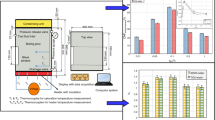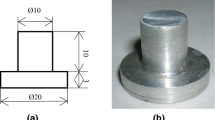Abstract
In this study, pool-boiling experiments are carried out to find out the influence of nanoparticles on boiling heat transfer coefficient and CHF. Each surface of the heater is visualized with FE-SEM and AFM after the experiments to figure out the effective boiling areas. The CHF increases up to 103% (compared to pure water) as the particle concentration increases until 0.001 vol% while it starts to decrease gradually as the particle concentration increases more than 0.001 vol%. It is found that the increase of CHF is proportional to the effective boiling surface area and the reduction of boiling heat transfer coefficient (BHTC) is mainly attributed to the blocking of the active nucleation cavity and the increase of the heat transfer resistance by nanoparticle deposition on the boiling surface. Finally, this study proposes a novel mechanism for BHTC reduction and CHF enhancement by nanofluids by considering the effective surface area variation.
Similar content being viewed by others
References
S. U. S. Choi, Enhancing thermal conductivity of fluids with nanoparticles, ASME FED Vol. 231/MD Vol. 66 (1995) 99–105.
S. Lee, S. U. S. Choi, S. Li and J. A. Eastman, Measuring thermal conductivity of fluids containing oxide nanoparticles, J. Heat Transfer, 121 (1999) 280–289.
S. K. Das, N. Putra and W. Roetzel, Pool boiling characteristics of nano-fluids, Int. J. Heat Mass Transfer, 46 (2003) 851–862.
J. Y. Jung and J. Y. Yoo, Thermal conductivity enhancement of nanofluids in conjunction with electrical double layer (EDL), Int. J. Heat Mass Transfer, 52 (2009) 525–528.
S. M. Kwark, R. Kumar, G. Moreno, J. Yoo and S. M. You, Pool boiling characteristics of low concentration nanofluids, Int. J. Heat Mass Transfer, 53 (2010) 972–981.
J. Y. Jung, C. Cho, W. H. Lee and Y. T. Kang, Thermal conductivity measurement and characterization of binary nanofluids, Int. J. Heat Mass Transfer, 54 (2011) 1728–1733.
H. Y. Sul, J. Y. Jung and Y. T. Kang, Thermal conductivity enhancement of binary nanoemulsion (O/S) for absorption application, Int. J. Heat Mass Transfer, 54 (2011) 1649–1653.
J. Y. Jung, H. S. Oh and H. Y. Kwak, Forced convective heat transfer of nanofluids in microchannels, Int. J. Heat Mass Transfer, 52 (2009) 466–472.
S. M. You, J. H. Kim and K. H. Kim, Effect of nanoparticles on critical heat flux of water in pool boiling heat transfer, Appl. Phys. Lett., 83 (2003) 3374–3376.
S. J. Kim, I. C. Bang, J. Buongiorno and L. W. Hu, Surface wettability change during pool boiling of nanofluids and its effect on critical heat flux, Int. J. Heat Mass Transfer, 50 (2007) 4105–4116.
H. D. Kim, J. Kim and M. H. Kim, Experimental studies on CHF characteristics of nano-fluids at pool boiling, Int. J. Multiphase Flow, 33 (2007) 691–706.
J. Y. Jung, J. Koo and Y. T. Kang, Model for predicting the critical size of aggregates in nanofluids, J. Mech. Sci. Tech., in press (2013).
J. P. Holman, Experimental methods for engineers, 7th ed. McGraw-Hill: New York (2001).
W. M. Rohsenow, A method of correlation heat-transfer data for surface boiling of liquids, ASME Trans., 74 (1952) 969–976.
N. Zuber, Hydrodynamic aspects of boiling heat transfer. In Physics and Mathematics, AEC: 1959.
J. Y. Jung, E. S. Kim and Y. T. Kang, Stabilizer effect on CHF and boiling heat transfer coefficient of alumina/water nanofluids, Int. J. Heat Mass Transfer, 55 (2012) 1941–1946.
J. Y. Jung, H. Kim and M. H. Kim, Effect of ionic additive on pool boiling critical heat flux of titania/water nanofluids, Heat Mass Transfer, 49 (2013) 1–10.
K. J. Park, D. Jung and S. E. Shim, Nucleate boiling heat transfer in aqueous solutions with carbon nanotubes up to critical heat fluxes, Int. J. Multiphase Flow, 35 (2009) 525–532.
I. C. Bang and S. H. Chang, Boiling heat transfer performance and phenomena of Al2O3-water nano-fluids from a plain surface in a pool, Int. J. Heat Mass Transfer, 48 (2005) 2407–2419.
J. Y. Jung, E. S. Kim, Y. Nam and Y. T. Kang, The study on the critical heat flux and pool boiling heat transfer coefficient of binary nanofluids (H2O/LiBr + Al2O3), Int. J. Refrig., 36 (2013) 1056–1061.
S. K. Roy Chowdhury and R. H. S. Winterton, Surface effects in pool boiling, Int. J. Heat Mass Transfer, 28 (1985) 1881–1889.
Y. Fukada, I. Haze and M. Osakabe, The effect of fouling on nucleate pool boiling of small wires, Heat Transfer-Asian Research, 33 (2004) 316–329.
S. M. Kwark, M. Amaya and S. M. You, Experiemental pool boiling heat transfer study of the nanoporous coating in various fluids, Int. J. Air-Conditioning Refrigeration, 20, (2012) 1150001.
Y. Takata, S. Hidaka and M. Kohno, Effect of surface wettability on pool boiling: enhancement by hydrophobic coating, Int. J. Air-Conditioning Refrigeration. 20 (2012) 1150003.
J. Y. Jung and H. Y. Kwak, Effect of surface condition on boiling heat transfer from silicon chip with submicron-scale roughness, Int. J. Heat Mass Transfer, 49 (2006) 4543–4551.
Author information
Authors and Affiliations
Corresponding author
Additional information
Recommended by Editor Haecheon Choi
Jung-Yeul Jung received his B.S., M.S. degrees, and Ph.D. in Mechanical Engineering from Chung-Ang University in 2001, 2003 and 2007, respecttively. He is a senior researcher of Korea Institute of Ocean Science and Technology (KIOST) and an associate professor of Korea Maritime University (KMU). His research interests are carbon capture and storage (CCS), heat & mass transfer, nanofluids, biosensors and heat exchangers.
Eung Surk Kim received his B.S. and M.S. degrees in Mechanical Engineering from Kyung Hee University in 2009 and 2011, respectively. Currently, he is a researcher of development & design in Hanwha engineering & construction corp. business center team. His research interests are plant basic & detail design, heat & mass transfer and design of equipment.
Yong Tae Kang received his B.S., M.S. degrees and Ph.D. in Mechanical Engineering from Seoul National University in 1987 and 1989, and The Ohio State University in 1994, respectively. Currently, he is a Professor at the Department of Mechanical Engineering, Kyung Hee University, Yongin, Korea. His research interests are CO2 absorption & regeneration, heat & mass transfer, nanofluids, heat pump and air conditioning and refrigeration.
Rights and permissions
About this article
Cite this article
Kim, E.S., Jung, JY. & Kang, Y.T. The effect of surface area on pool boiling heat transfer coefficient and CHF of Al2O3/water nanofluids. J Mech Sci Technol 27, 3177–3182 (2013). https://doi.org/10.1007/s12206-013-0839-7
Received:
Revised:
Accepted:
Published:
Issue Date:
DOI: https://doi.org/10.1007/s12206-013-0839-7




